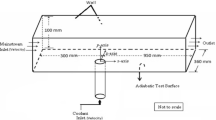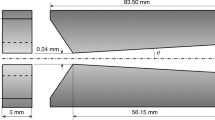Abstract
An experimental study was conducted to investigate the effect of fuel boiling point on the hydraulic characteristics of high-temperature liquid jets, simulating injection of fuel used as coolant in the active cooling systems of a hypersonic flight vehicle. Two hydrocarbon fuels were specially created to have higher boiling points than conventional aviation fuels. The fuels were heated to close to 573 K (300 °C) using an induction heater at an upstream pressure of up to 1.1 MPa, and discharged to atmospheric downstream pressure conditions through a plain orifice nozzle of diameter 0.7 mm. The fundamental hydraulic characteristics represented in Cd with respect to Tinj at three injection pressure conditions for the three fuels show that the temperatures at which Cd begins to decrease are very close to each fuel’s boiling or bubble point and remain almost constant for each fuel even when ∆P is varied. In the relationship between Cd and Re, the discharge coefficients, which are almost identical regardless of fuel and ΔP conditions in relatively low ranges of Re, begin to deviate and decrease sharply as Re increases, due to the collapse of the mass flow rate induced by the choked cavitation. The present results also confirm that the effect of fuel boiling point on thermal cavitation at temperatures above the boiling point is well correlated with the relationship between Cd and cavitation number, and the degree of choked cavitation as quantified by the cavitation numbers collapses to almost the same line, even for fuels with different boiling or bubble points.










Similar content being viewed by others
Abbreviations
- A o :
-
Outlet (orifice) area of the injector (m2)
- Ca :
-
Cavitation number, \( Ca = \frac{{P_{\infty } - P_{\text{sat}} }}{{\rho V^{2} /2}} \)
- C d :
-
Discharge coefficient, \( C_{\text{d}} = \frac{{\dot{m}_{\text{f}} }}{{A_{\text{o}} \sqrt {2\rho_{\text{l}} \Delta P} }} \)
- D :
-
Diameter of orifice (m)
- K :
-
Cavitation number, \( K = \frac{{P_{\text{inj}} - P_{\text{sat}} }}{{P_{\text{inj}} - P_{\infty } }} \)
- L :
-
Length of orifice (m)
- \( \dot{m}_{\text{f}} \) :
-
Fuel mass flow rate (kg/s)
- P ∞ :
-
Ambient pressure (MPa)
- P inj :
-
Injection pressure (MPa)
- P sat :
-
Saturation vapor pressure (MPa)
- Re :
-
Reynolds number, \( Re = \frac{{\rho_{\text{l}} VD}}{{\mu_{\text{l}} }} \)
- T inj :
-
Fuel injection temperature (K)
- T ref :
-
Reference temperature (K)
- T sat :
-
Saturation temperature (K)
- V :
-
Average injection velocity (m/s)
- ΔP :
-
Pressure drop across the injector, ΔP = Pinj−P∞
- μ l :
-
Liquid viscosity (Pa s)
- ρ l :
-
Liquid density (kg/m3)
References
Van Wie DM, D’Alessio SM, White ME (2005) Hypersonic air-breathing propulsion. Johns Hopkins APL Technol Digest 26:430–437
National Research Council (1998) Review and evaluation of the air force hypersonic technology program. National Academy Press, Washington, DC, pp 5–17
Cooper M, Shepherd JE (2002) Thermal and catalytic cracking of JP-10 for pulse detonation engine applications, GALCIT Report FM 2002.002, Caltech
Gasner JA, Foster RC, Fujimura C (1992) Evaluation of thermal management for a Mach 5.5 hypersonic vehicle, AIAA 92-3721
Sobel DR, Spadaccini LJ (1997) Hydrocarbon fuel cooling technologies for advanced propulsion. ASME J Eng Gas Turbines Power 119:344–351
Soteriou C, Andrews R, Smith M (1995) Direct injection diesel sprays and the effect of cavitation and hydraulic flip on atomization. In: SAE international congress and exhibition 1995, paper no. 950080
Aleiferis PG, Serras-Pereira J, Augoye A, Davies TJ, Cracknell RF, Richardson D (2010) Effect of fuel temperature on in-nozzle cavitation and spray formation of liquid hydrocarbons and alcohols from a real-size optical injector for direct-injection spark ignition engines. Int J Heat Mass Transf 53:4588–4606
Sher E, Bar-Kohany T, Rashkovan A (2008) Flash-boiling atomization. Progress Energy Combust Sci 34:417–439
Nurick WH (1976) Orifice cavitation and its effect on spray mixing. ASME J Fluids Eng 98:681–687
Payri R, Salvador FJ, Gimeno J, de la Morena J (2009) Study of cavitation phenomena based on a technique for visualizing bubbles in a liquid pressurized chamber. Int J Heat Fluid Flow 30:768–777
Cioncolini A, Scenini F, Duff J, Szolcek M, Curioni M (2016) Choked cavitation in micro-orifices: an experimental study. Exp Thermal Fluid Sci 74:49–57
Lee HJ, Jin Y-I, Choi H, Hwang K-Y (2017) Hydraulic characterization of high temperature hydrocarbon liquid jets. Int J Heat Fluid Flow 65:166–176
Lee HJ, Choi H, Hwang K-Y, Park D-C, Min S (2017) Numerical study of choked cavitation in high temperature hydrocarbon liquid jets. Int J Heat Fluid Flow 68:114–125
Payri R, Guardiola C, Salvador FJ, Gimeno J (2004) Critical cavitation number determination in diesel injection nozzles. Exp Tech 28:49–52
Lee HJ, Choi H, Jin Y-I, Hwang K-Y, Park D-C, Min S (2018) Effect of nozzle inlet geometry in high temperature hydrocarbon liquid jets. Int J Heat Fluid Flow 74:1–14
Lee HJ, Choi H, Park D-C (2018) Hydraulic characteristics of high temperature hydrocarbon liquid jets with various orifice geometries. Acta Astronaut 152:657–666
Bruno TJ, Huber ML, Laesecke A, Lemmon EW, Perkins RA (2006) Thermochemical and thermophysical properties of JP-10, NISTIR 6640, national institute of standards and technology
Coordinating Research Council (2004) Handbook of aviation fuel properties, 3rd ed, CRC report no. 635
Singh SG, Bhide RP, Duttagupta SP, Puranik BP, Agrawal A (2009) Two-phase flow pressure drop characteristics in trapezoidal silicon microchannels. IEEE Trans Compon Packaging Technol 32(4):887–900
Duryodhan VS, Singh A, Singh SG, Agrawal A (2015) Convective heat transfer in diverging and converging microchannels. Int J Heat Mass Transf 80:424–438
Xing Y, Guo Y, Li D, Fang W, Lin R (2007) Measurement of bubble point vapor pressure for systems of JP-10 with ethanol. Energy Fuels 21:1048–1051
Beckwith TG, Thomas G, Marangoni RD, Lienhard JH (1993) Mechanical measurements. Addison Wesley, New York
Vieira MM, Simoes-Moreira JR (2007) Low-pressure flashing mechanisms in iso-octane liquid jets. J Fluid Mech 572:121–144
Lamanna G, Kamoun H, Weigand B, Steelant J (2014) Towards a unified treatment of fully flashing sprays. Int J Multiph Flow 58:168–184
Edwards T (2006) Cracking and deposition behavior of supercritical hydrocarbon aviation fuels. Combust Sci Technol 178:307–334
Hou L-Y, Dong N, Ren Z-Y, Zhang B, Hu S-L (2014) Cooling and coke deposition of hydrocarbon fuel with catalytic steam reforming. Fuel Process Technol 128:128–133
Fox RW, McDonald AT, Pritchard PJ (2004) Introduction to fluid mechanics, 6th edn. Wiley, Hoboken
Funding
This research did not receive any specific grant from funding agencies in the public, commercial, or not-for-profit sectors.
Author information
Authors and Affiliations
Corresponding author
Ethics declarations
Conflict of interest
The author(s) declare that they have no conflict of interests.
Additional information
Publisher's Note
Springer Nature remains neutral with regard to jurisdictional claims in published maps and institutional affiliations.
Rights and permissions
About this article
Cite this article
Yoo, Y.J., Lee, H.J., Choi, H. et al. Influence of Fuel Boiling Point on Discharge Characteristics of Superheated Hydrocarbon Liquid Jets. Int. J. Aeronaut. Space Sci. 21, 186–200 (2020). https://doi.org/10.1007/s42405-019-00214-0
Received:
Revised:
Accepted:
Published:
Issue Date:
DOI: https://doi.org/10.1007/s42405-019-00214-0




